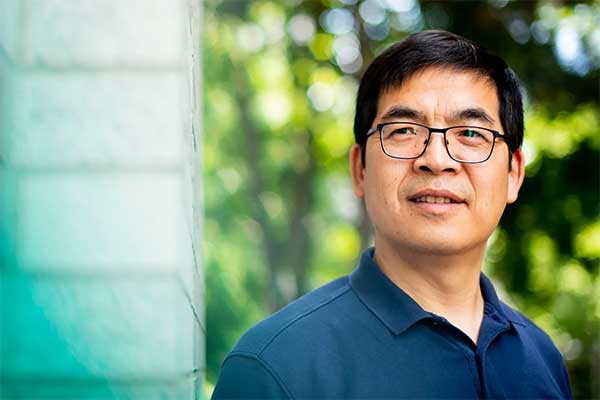Sun Selected as APS Fellow

ECE Distinguished Professor Nian Sun was selected as a Fellow of the American Physical Society by the Topical Group on Magnetism and its Applications (GMAG) for his innovations in high magnetization materials, magnetoelastic and magnetoelectric thin film materials, microsystems, and device physics. Fellows are recognized for excellence in physics and exceptional service to the physics community.
This article originally appeared on Northeastern Global News. It was published by Noah Lloyd. Main photo: Nian Sun, distinguished professor of electrical and computer engineering. Photo by Ruby Wallau/Northeastern University.
From microelectronics to cancer sensors: Nian Sun elected fellow of American Physical Society
Nian Sun, a distinguished professor of electrical and computer engineering at Northeastern University, is revolutionizing magnetoelectric materials, which are used in everything from microelectronics to biomedical devices that can “smell” cancer.
Now, Sun has been elected a fellow of the American Physical Society (APS), the largest association of physicists in the world.
The fellowship is recognizing Sun for “innovations in high magnetization materials, magnetoelastic and magnetoelectric thin film materials, microsystems, and device physics.”
“Antennas are everywhere,” Sun says, from tiny ones in our cellphones to those that are “meters tall” or even “miles across,” in the case of some low-frequency antennas used to communicate with submarines deep beneath the ocean.
Previously, giant antennas like these, which are “mounted on a mountain,” Sun notes, were needed to penetrate the thousands of feet of water that might separate a military submersible from its onshore commanders.
This also means that when a submarine is deeply submerged, it has no way of communicating with the above-the-water world.
“Our magnetoelectric antenna,” Sun says, can be produced to be “so small that it’s palm sized instead of miles across.”
This reduction “by several orders of magnitude,” Sun says, will also mean that, suddenly, submersible communication can be bidirectional. “That is, we can send signals from underwater to the shore and vice versa,” he says.
Breaking, as Sun calls it, the “water-air communication barrier.”
“That’s something that really is revolutionary,” he says. “I think that this will have a huge impact on a lot of things we work on.”
Read Full Story at Northeastern Global News